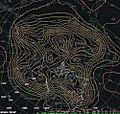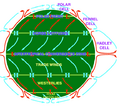Troposphere facts for kids
The troposphere is the lowest part of Earth's atmosphere. It's the layer closest to us, where we live and breathe.
This is where most of Earth's weather happens, like rain, snow, thunder, and storms. Clouds can form here, reaching heights of up to 10–15 kilometers (about 6–9 miles).
In the troposphere, the air temperature usually gets colder as you go higher up. This is different from the layer above it, the stratosphere. Because of this temperature change, the troposphere is quite active. Air can easily move up and down, mixing everything around. This constant movement helps create the general patterns of how air moves around the planet.
Contents
What is the Troposphere?
The word troposphere comes from two ancient Greek words: tropos, meaning "rotating" or "turning," and sphaira, meaning "sphere." This name makes sense because the air in this layer is always moving and mixing.
The troposphere contains most of the air in our atmosphere. About 80% of the total mass of the planetary atmosphere is found here. It also holds almost all of the water vapor (which forms clouds and rain) and tiny particles called aerosols.
The average height of the troposphere changes depending on where you are on Earth:
- Near the equator (the middle of Earth), it's about 18 kilometers (11 miles) high.
- In the middle parts of the world, it's about 17 kilometers (10.5 miles) high.
- Near the polar regions (the North and South Poles) in winter, it's only about 6 kilometers (3.7 miles) high.
So, on average, the troposphere is about 13 kilometers (8 miles) high.
The boundary between the troposphere and the next layer, the stratosphere, is called the tropopause.
How Does Temperature Change in the Troposphere?
The ground and oceans on Earth's surface warm up the troposphere. This happens in a few ways:
- Latent heat: When water evaporates from the surface, it takes heat with it. This heat is released into the air when the water vapor condenses to form clouds.
- Thermal radiation: The Earth's surface absorbs sunlight and then gives off heat as thermal radiation.
- Sensible heat: This is the direct transfer of heat from the warm ground to the cooler air above it.
The air layers in the troposphere are thinner near the geographical poles and thicker near the equator. This is because the equator gets more direct sunlight, which heats the air more and causes it to expand upwards.
Let's look at how temperatures change from the ground up to the tropopause:
- In the middle parts of the world, the temperature drops from about 15°C (59°F) at sea level to around -55°C (-67°F) at the tropopause.
- Near the equator, it's warmer at sea level, about 20°C (68°F). But it gets much colder higher up, reaching about -70°C to -75°C (-94°F to -103°F) at the tropopause.
- At the Arctic and Antarctic poles, the temperature starts around 0°C (32°F) at sea level and drops to about -45°C (-49°F) at the tropopause.
How Does Air Move in the Troposphere?
The air in the troposphere generally flows from west to east around the Earth. Imagine a giant river of air moving across the globe.
However, this west-to-east flow can sometimes be interrupted by "polar flows." These are movements of air either from north to south or from south to north. These changes in air patterns can bring different weather conditions to various regions. This constant movement and mixing of air is what causes our daily weather changes.
Images for kids
-
Diagram showing the five primary layers of the Earth's atmosphere: exosphere, thermosphere, mesosphere, stratosphere, and troposphere. The layers are to scale. From Earth's surface to the top of the stratosphere (50 km) is just under 1% of Earth's radius.
-
A view of Earth's troposphere from an airplane.
See also
 In Spanish: Troposfera para niños
In Spanish: Troposfera para niños





